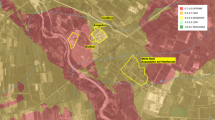Abstract
The results of a generalization and analysis of data accumulated over a period of 40 years on the actual gas release from injected wells in test areas for underground disposal of liquid wastes with various levels of activity from the Siberian Integrated Chemical Plant and the Zheleznogorskii Integrated Mining and Chemical Plant are presented. It is concluded that in order to extend the operation of the test areas beyond the prescribed time limits the presence of a gas phase in the reservoir formations, formed over the period during which they were actively used, must be taken into account carefully. The investigations should be extended to the problem of gas release and priority must be given to determining the contribution of the different components of this process and investigating their mechanisms and to developing a mathematical model of gas release and a computer program to predict the development in order to ensure safe operation of the areas used to test underground disposal.
Similar content being viewed by others
References
A. I. Rybalchenko, M. K. Pimenov, P. P. Kostin, et al., Deep Disposal of Liquid Radioactive Wastes, IzdAT, Moscow (1994).
V. A. Grabovnikov (ed.), Hydrogeological Investigations for Validating Undergound Disposal of Industrial Liquid Wastes, Nedra, Moscow (1993).
W. Barton, J. Brothers, S. Bryan, et al., Flammable Gas Project, Topical Report, Rev. 1, F-SP-11 UC-2030, December 1996.
T. N. Nazina, I. M. Kosareva, A. S. Davydov, et al., “Physicochemical and microbiological characteristics of underground waters from observation wells for deep disposal of liquid radioactive wastes,” Mikrobiologiya, 69, No. 1, 105–112 (2000).
M. M. Arkhipova, I. M. Kosareva, E. G. Kudryavtsev, et al., “Physicochemial and microbiological characteristics of formation fluids of the deep repository of liquid radioactive wastes,” in: Proceedings of the 8th International Conference on Radioactive Waste Management and Environmental Remediation, September 30–October 2, 2001, Bruges, Belgium, p. 42.
I. M. Kosareva, M. K. Savushkina, M. M. Arkhipova, et al., “Temperature field of deep burial of liquid radioactive wastes,” At. Énerg., 85, No. 6, 441–448 (1998).
I. M. Kosareva, M. K. Savushkina, M. M. Arkhipova, et al., “Temperature field of deep burial of liquid radioactive wastes: simulation of multistage disposal,” At. Énerg., 89, No. 6, 435–440 (2000).
Yu. A. Namiot, Handbook of the Solubility of Gases in Water, Nedra, Moscow (1991).
Author information
Authors and Affiliations
Additional information
__________
Translated from Atomnaya Énergiya, Vol. 100, No. 1, pp. 45–50, January, 2005.
Rights and permissions
About this article
Cite this article
Kosareva, I.M., Savushkina, M.K., Ershov, B.G. et al. Gas release from deeply buried liquid radioactive wastes. At Energy 100, 47–52 (2006). https://doi.org/10.1007/s10512-006-0048-x
Received:
Issue Date:
DOI: https://doi.org/10.1007/s10512-006-0048-x



